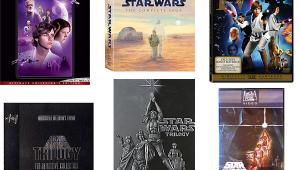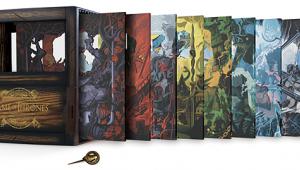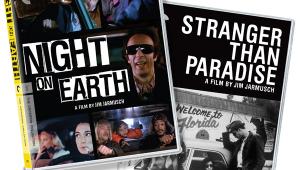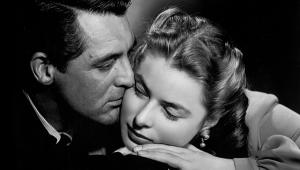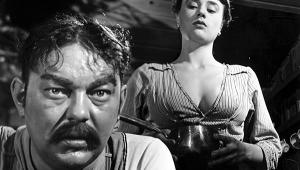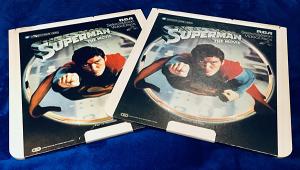With a Bang or a Whimper
The Day After Tomorrow: All Access Collector's Edition
Dennis Quaid, Jake Gyllenhaal, Ian Holm, Emmy Rossum, Sela Ward. Directed by Rowland Emmerich. Aspect ratio: 2.35:1(anamorphic). 123 minutes. 2004. 5.1 Dolby Surround and 5.1 DTS (English), Dolby Surround (Spanish and French). 20th Century Fox Home Entertainment. PG-13. $26.98.
Picture **1/2
Sound ***
Film * (FM)
Film ** (TJN)
As you scarf down those Fourth of July hot dogs, recall that it was nine years ago when director Rowland Emmerich elbowed his way into the holiday with his first major disaster flick, Independence Day. Since then he has destroyed civilization at least twice more, once with a big lizard originally of Japanese origin, and most recently with really bad weather. (Some would also argue that he did major damage to American history with The Patriot.)
The really bad weather comes by way of The Day After Tomorrow. Released on DVD last year, it has recently been re-issued as an All Access Collector's Edition. The first disc appears to be identical in content to the (still available) single-disc release of the movie, from its audio tracks to its two filmmaker commentaries.
The whole point of the Special Edition, apart from pumping up sales, appears to be the special features on the new second disc. Many of these extras are short and not overly compelling, though a pre-visualization featurette is a fascinating look at the advances in computer-animated storyboards.
But many will find the hour-long documentary, "The Forces of Destiny: The Science and Politics of Climate Change" of interest. It will either make you nod your head in agreement or shake it in frustration—because it is (as you would expect considering the film it accompanies), a one-sided look at the issue. In its critiques of the burning of fossil fuels, I kept waiting for the phrase "nuclear power" to pass someone's lips. It never did. To be fair, pollution-fueled climate change is a serious issue, but an exceptionally complex one involving dozens of countries with dozens of different priorities.
One downside of The Day After Tomorrow (among many!) is that by time-compressing the potential sequence of events, it made the whole scenario into little more than a summer popcorn fantasy. Before this film came out, environmental activists were excited by its potential to energize the public. After its release, they were largely silent about it.
I enjoyed the movie a little more than Fred Manteghian did—again, in a summer potboiler, spectacular effects kind of way.—TJN
The Day After Tomorrow
Fred Manteghian
FM reviewed the film from the standard edition; as far as we can tell, the Special Edition has an identical audio and video transfer.
Two thirds of the way through "The Day After Tomorrow," books at the New York City Library are thrown into a fireplace to take the chill out of the air. Too bad the script to this turkey wasn't among the offerings. The concept is simple—environmentally insensitive politicians ignore Kyoto, thus giving global warming an inferiority complex that causes it to lay an ice age on the planet. Implausible, sure, but that's what passes as science to high-school dropouts, Hollywood intelligentsia, and—oh wait, I'm being redundant.
A lone scientist, Jack Hall (Quaid), studying past ice ages, presents a paper at a meteorological convention in India. A few days later, his predictions start coming true with a vengeance. Meanwhile, his son Sam (Gyllenhaal) travels from Baltimore to New York City, where he and classmates compete in a Trivial Pursuits decathlon or something. When the storms strike, the geek squad takes refuge in the New York City Library, where, following instructions from his father, they sit out the storm. Meanwhile, Jack Hall gets an audience with the President, presents his analysis, and then takes off to New York to get his son back. I could tell you the ending, but I'll let the director ruin it for you instead.
Dennis Quaid seems distracted throughout the movie, with a self-conscious glint in his eyes that looked like a cry for help to me. Jake Gyllenhaal (Donnie in "Donnie Darko" and the kid that shoulda been Spidey, too) puts on a better performance, but there's only so much you can do with such tripe. As for the remaining characters in the movie, I think the parts were filled by anyone who could feign shivering on demand.
The best performances, of course, were brewed up in the computer lab and starred tidal waves, flying billboards, and freezing buildings. Perhaps the directors hoped the special effects would cover up deficiencies in the plot, a time-honored tradition that is not without precedent. But even the human subplots, the staple of disaster films from time immemorial, are never fully sketched out, leaving us wishing that the movie spent more time developing characters and less time killing them off.
If you don't buy the science, you're not going to be impressed with the math either. Dennis Quaid walks 40 miles in a snowstorm from New Jersey to Manhattan, via the Statue of Liberty, in two days. It sounds implausible until you realize there weren't any delays at the George Washington bridge.
The video transfer is soft much of the time, but perhaps that was a conscious decision that helped meld the CGI graphics with the live action without seeming too cartoonish. Black levels are fine, though this movie is about snow and baseball-sized hail, not dungeons or dragons.
The music, while derivative, is at least influenced by the classics, and the closing credits were more than just a little reminiscent of The Planets by Holst. The score, by Harald Kloser and Thomas Wanker, deserves credit for an appropriate and effective backdrop for a big-budget disaster film. The Dolby Digital soundtrack is superior for dialog, but the DTS track has a slight edge on musical impact.
On the standard edition I reviewed, two deleted scenes and two commentary tracks comprise the most interesting special features accessible from your DVD player. Getting to the rest of the bonus material, including behind-the-scenes vignettes, means accepting and installing a skin for your Microsoft Windows Media player. Exactly how much more you may want to know after watching this film—other than the amount of time just wasted was two hours—is open to debate.
The War of the Worlds
Thomas J. Norton
Gene Barry, Ann Robinson, Less Tremayne. Directed by Byron Haskin. Aspect ratio: 1.33:1. 85 minutes. 1953. Dolby Digital Mono (English and French). Paramount Home Entertainment 053037. Not Rated. $ (see text)
Picture **1/2
Sound **1/2
Film ***
The War of the Worlds, from 1952, was one of any number of realizations of H.G. Wells' popular novel, including Orson Welles' famous 1938 Halloween radio broadcast and a schlocky 1980s TV series. The latest re-imagining is, of course, the just-released, would-be blockbuster from director Steven Spielberg. As I write this, I haven't seen it, but it has its work cut out for it to equal the scary impact of this classic, at least as it appears through my Way-Back mirror.
As a major release, this earlier film would be unlikely to impress current audiences, even though the special effects still hold up remarkably well. Yes, they were limited by the resources and technology available in 1953. The opening shots of the destruction caused by the Martian invasion probably looked like the stock WWII footage they were even on its initial release. But the Martian machines remain a wonder even today—simple yet sleekly real-looking except for. . .on second thought, see the spoiler at the end of this review for more thoughts on the special effects.
Despite its technical limitations, I still remember the first time I saw the film—an 11-year-old shaking in fear and thrilling to every minute. It certainly turned me on to the wonders of science fiction. The scene in that smashed farmhouse—yikes! This film inspired dozens of otherworldly imitators in the 1950s (none of them anywhere near as good), and it had a strong influence on later films as well.
There's nothing much wrong with this transfer that can't be blamed on limitations of the original source. It's the standard 1.37:1 aspect ratio dominant in 1953 (for some reason, the jacket says it was "formatted to fit your TV"). Had it been made two years later, it might well have been in Cinemascope. But the upside to the 1953 release date is that the film was shot in glorious Technicolor, and it has not suffered the age-related fading and discoloration that plagues many widescreen films released with the newer color processes prevalent in most 1950s widescreen films. The mono sound is remarkably effective for a film this old, and while ears accustomed to 2005 movie sound may be initially disappointed, once you get into the film it's no distraction.
Unfortunately, this DVD is out of print, with a few new and used copies selling for outrageous prices on Amazon. But don't despair; Paramount is reportedly planning to re-release it this fall—not surprisingly, just as Spielberg's new version approaches its DVD release date. Hopefully, the re-release will include compelling extra features that are missing on this one. Stars Gene Barry and Ann Robinson—one of the best screamers in movie history—are still with us and reportedly have cameos in the new Spielberg version (though the one person I spoke with who saw the film couldn't spot them). A commentary track from them would be a real coup.
It would also be a plus if Paramount saw fit to include the multichannel soundtrack created for the laserdisc release but not present on this DVD. You can't generate a true surround sound mix from a mono source (which the original most definitely was), but the simulation I recall from the LD did add a pleasing and appropriate spaciousness to the proceedings.
(SPOILER ALERT) Either way, however, you owe it to yourself to see just how good this older film is—even though the resolving power of DVD (and a good video display) lets you spot the wires supporting those evil but beautiful Martian warships. You can also see one of the ships bobble slightly as it approaches the preacher attempting to communicate with it!
- Log in or register to post comments


